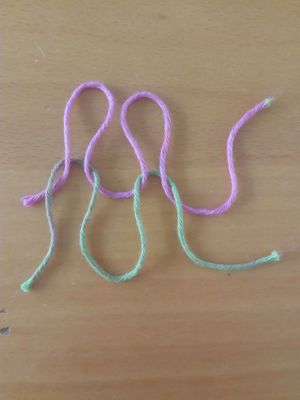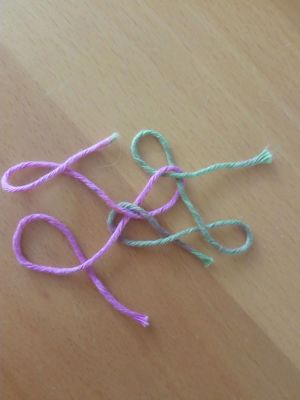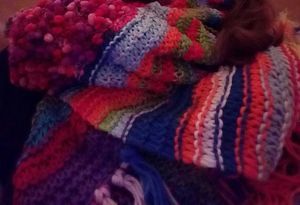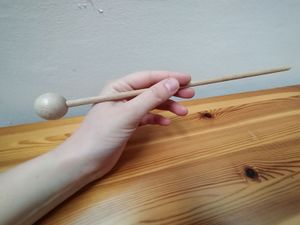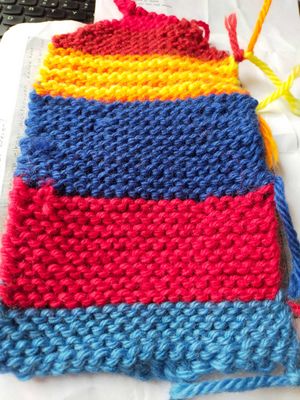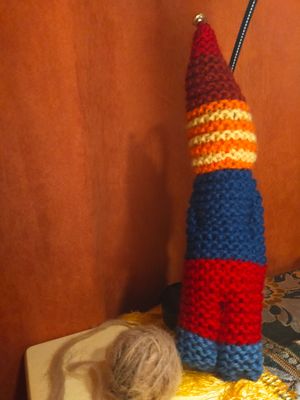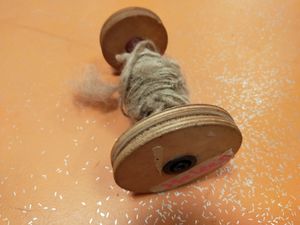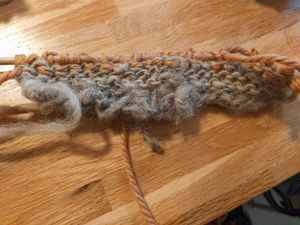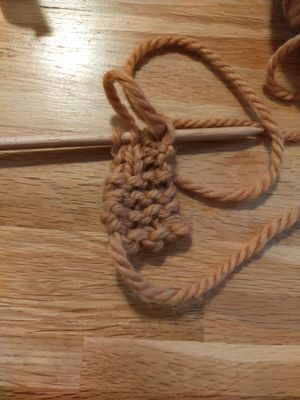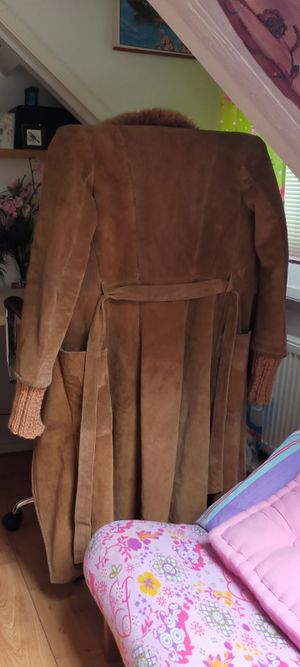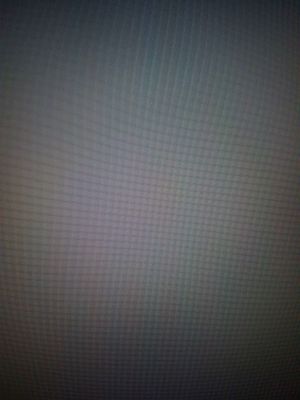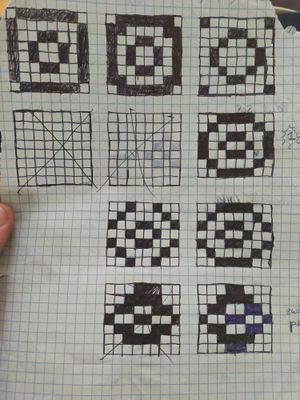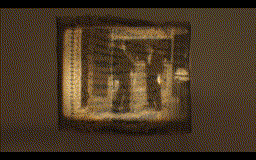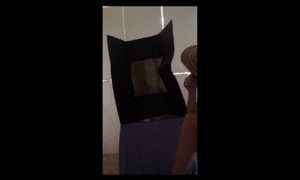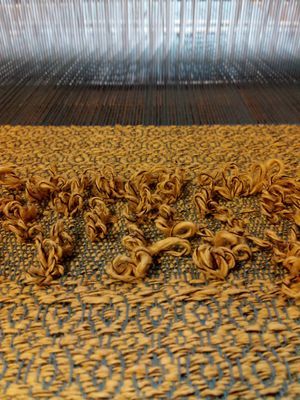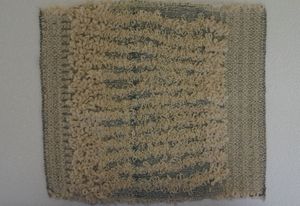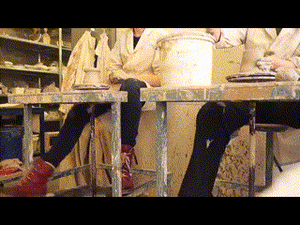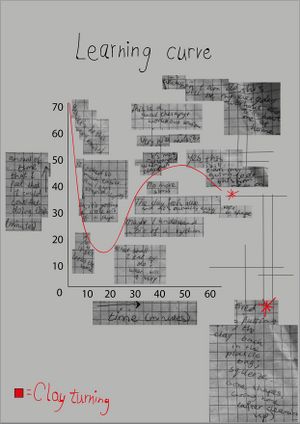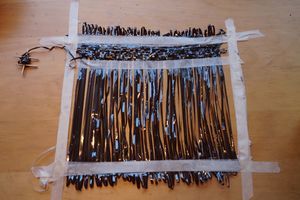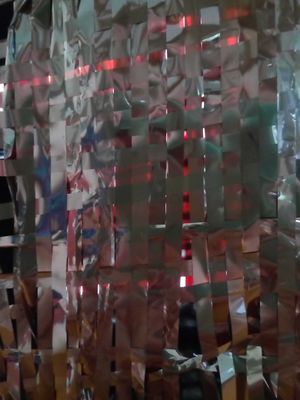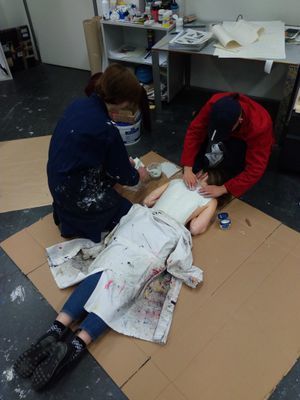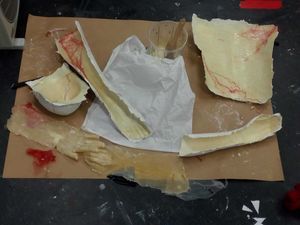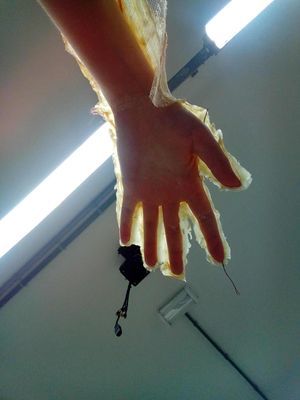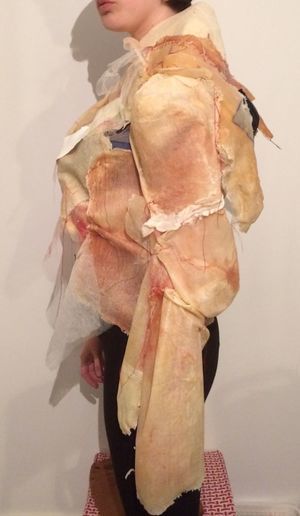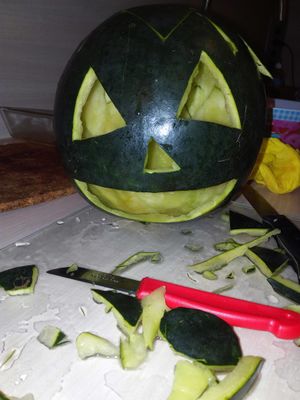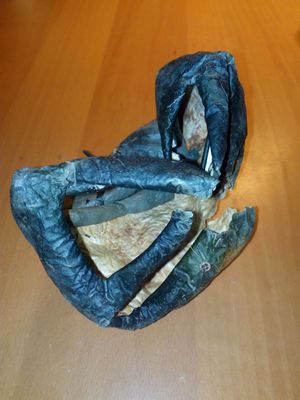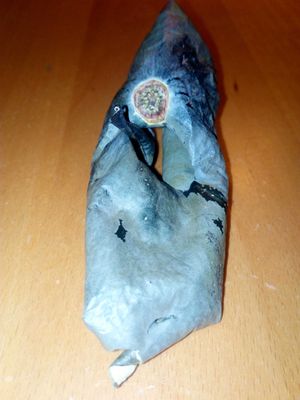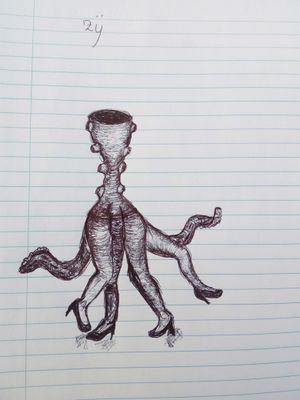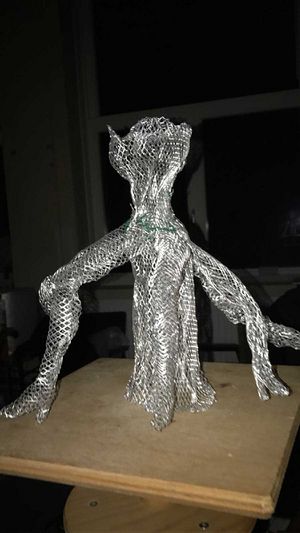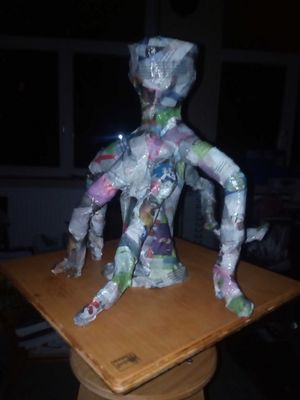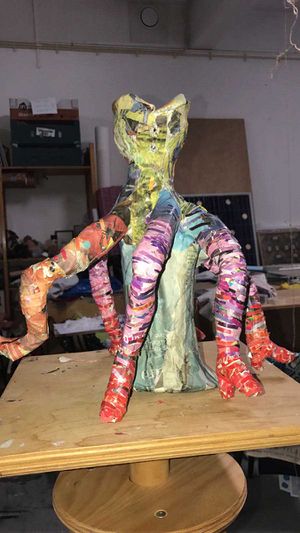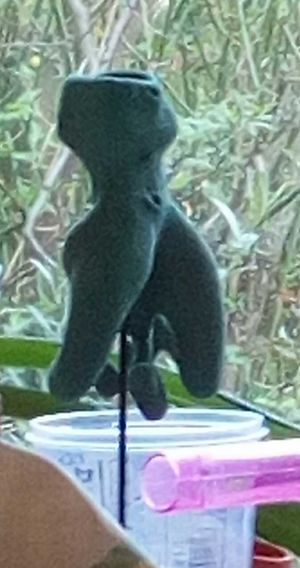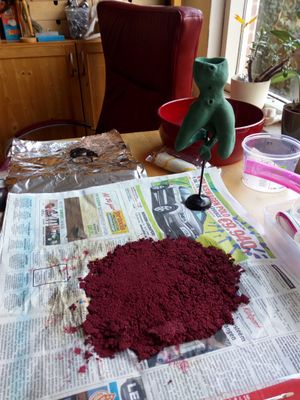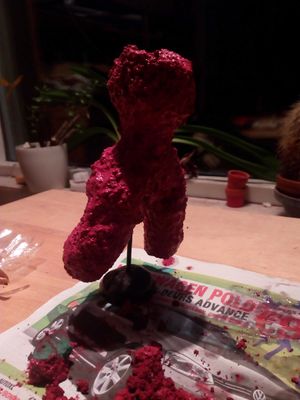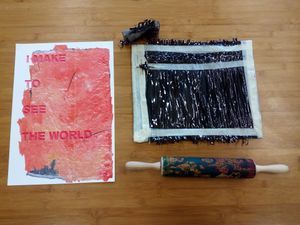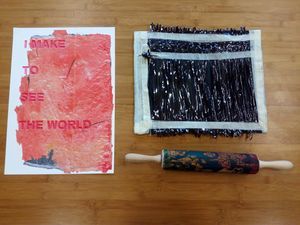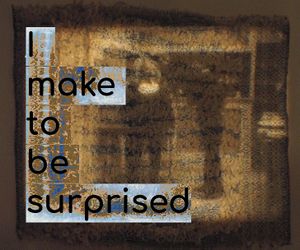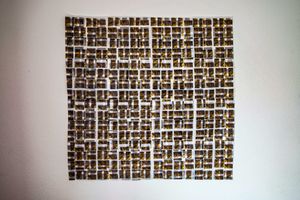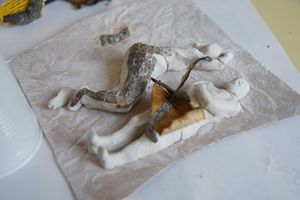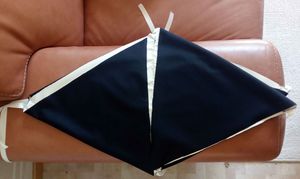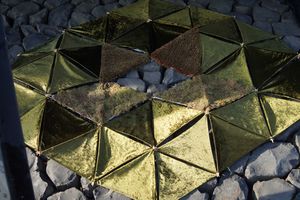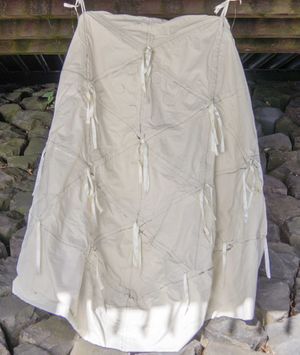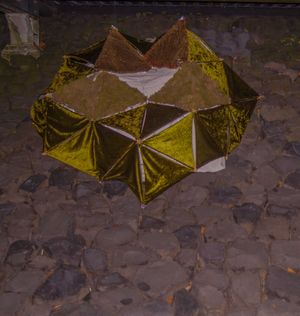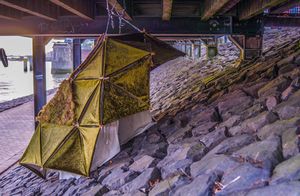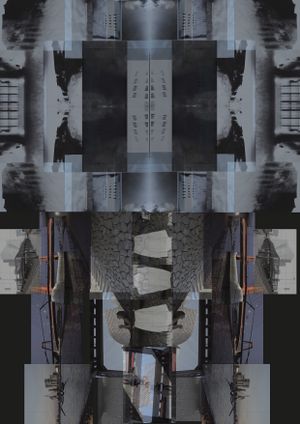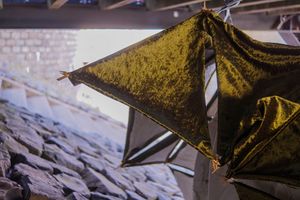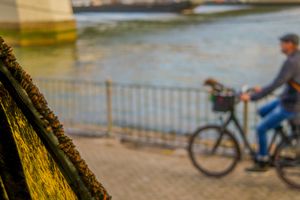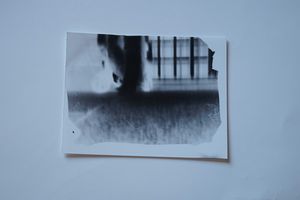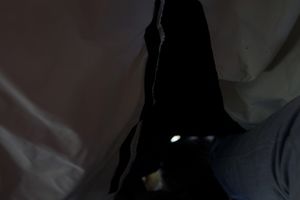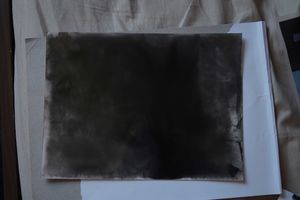User:0904492
Contents
- 1 Digital Craft - Making is connecting 2017 - Wrapping - Heleen Langstraat
- 1.1 Research
- 1.1.1 Theory
- 1.1.1.1 Politics of work and craft - Introducing two pioneers: Ruskin and Morris
- 1.1.1.2 Influence of Ruskin and Morris throughout history: Arts and Crafts movement, DIY movement and craftivism
- 1.1.1.3 Critique on the word “craft”
- 1.1.1.4 The battle of art and craft
- 1.1.1.5 Walter Gropius: Bauhaus Manifesto
- 1.1.1.6 Added notes from the 21st century about craft
- 1.1.1.7 Wrapping
- 1.1.1.8 The history of wrapping
- 1.1.1 Theory
- 1.2 Studio practice
- 1.3 Why I make
- 1.4 Continuation (epilogue)
- 1.1 Research
Digital Craft - Making is connecting 2017 - Wrapping - Heleen Langstraat
My name is Heleen Langstraat. I studied this practice during my second year of Fine Arts. Within this practice I'll explore the opportunities of craft by theoretical and practical research. So, at the end of this practice I'll be answering the question: Why do I make?
Research
In the research for this practice the focus lays on finding my own position towards craft and gaining context awareness of the topic. I was interested in this practice, because of the political discussions in the theory and because of the practice based research side: starting research from experiments- getting out of my usual thought patterns for a while.
Theory
In the practice digital craft we started by reading about different definitions of “craft”. It turned out to be a loaded term, the meaning of which depends on the place and person. The usual status of craft is sadly rather one of low value, because there’s the idea that it would lack intellectual creativity. Craft is mostly seen as the human activity of making objects for themselves and others in the offline, non-digital world ([1]).
Politics of work and craft - Introducing two pioneers: Ruskin and Morris
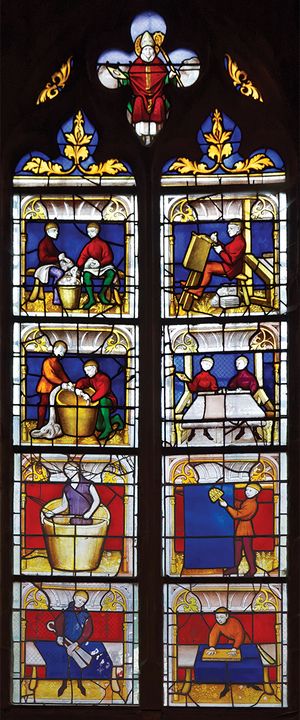
The discussion about craft took shape in the UK during the 19th century. Originally, craft meant something like “sly trickery”, but later on it was used to describe “manual art”, up to a point where it also meant “ability”. “Craft” took roughly three paths since the Industrial Revolution: decorative applied forms of creativity that are generally less valued than “fine art”, something handmade that’s associated with authenticity (of a community) and the condition in which someone works that becomes a priority over the finished product (politics of work). The third one strikes most with the message of Ruskin and Morris.
The Industrial Revolution brought with it philosophical and political protests about working circumstances. John Ruskin, Karl Marx and later William Morris provided their impactful perspectives. Ruskin (1819-1900, born in London) was an aquarellist, art critic and writer, who engaged in conservative politics with an emphasis on the value of community, the value of local organic production and on the care for all workers. Marx (1818-1883, born in Trier) was a master economist and philosopher, who wrote The Communist Manifesto together with Friedrich Engels. Morris (1834-1896, born in Walthamstow, UK) was an artist and entrepreneur, whose socialism is inspired by Ruskin. He aspired to create an art community in which people could enjoy making beautiful objects for everyday life.
In factory work in a capitalist society like the UK in the 19th century, there was a separation between the thinking and making parts. The thinking part decides what others will make and divides the tasks in segments; the makers have become operators. To demand of a person to operate and follow rules exactly, without any personal freedom, is to make one a tool. Ruskin fears the loss of creative and moral spirits: he focuses mainly on the importance of embracing one's creativity in a working environment, which would ideally be freely expressed and individual. A worker should be allowed to produce a whole thing. Ruskin seems to long back to the Middle Ages with their craft in the Labor Parties, because of the ornamentations that showed individual quirks and talents. For Marx this division of labor means a form of slavery, which he uses as an argument against capitalism in his manifesto. A lot of people have a terrible job and feel alienated from it, which leads to products of low quality. The “producers” (thinkers) are disconnected from the making process as well as the operators. Morris practices many kinds of art to produce beautiful everyday objects. He shows that if a person feels in the process that he has the power to leave a creative mark, it will empower the process and usually make an eventual product very beautiful in use and aesthetically: this feeling is the “joy de faire” (joy of making). Though he wishes to inspire many people around him already by letting them experience the beauty of craft, his products are quite exclusive and luxurious due to the fine materials and precise handicraft.
A true making process connects the intellectual with the physical work. Separating ideas from knowledge of how things are made cannot lead to creativity within the making process. When people can add their individual value in a collaboration, then there can exist a healthy community: a community (and hopefully society) that treasures living beings instead of exploiting them. Making things from natural materials is vital for us. The process gives us new ideas that have an influence on our daily life.
The three of them redefine wealth: wealth is about core values, like creativity and nature instead of “growth” or “innovation”. Growth and innovation seem empty and cost people more than they’re supposed to generate. Morris already even made a note that innovation should be used to take care of the environment.
In his book “The Revival of Handicraft” Morris’ vision about industrial production becomes even more clear:
Putting responsibility of production on fewer minds is a way of diminishing general intellect. Though some intellectuals may strive for some form of perfection and look upon machines as perfect executers for their ideas, in return people will forgot what a beautiful object is, actually, next to the handicraft techniques (with the joy de faire). They need material objects and so they will take what they get. After some time they will be used to the standards of this industrial production, while the standards of that production are only a vague middle of the consumers’ wishes. Besides, what will people have to do with all this time, when their handicraft doesn’t seem essential anymore? What will ugly products do for unproductive people? It is desirable is that mechanization will play a dynamic role in some revival of handicraft instead of creating an industry that doesn’t need humans and isn’t for real humans anymore ([3]).
Influence of Ruskin and Morris throughout history: Arts and Crafts movement, DIY movement and craftivism
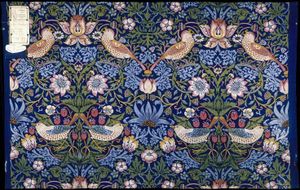
Ruskin’s and Morris’ ideas about work ethos seeped on to DIY culture in the 20th century via the Arts and Crafts movement. The Arts and Crafts movement was blossoming from 1887 till the First World War. This movement aimed to equally value all creative work, because creative workers contribute to a vibrant and dynamic culture by their individual share in production. Making things by hand allows one to connect with nature, a sense of self and other people. Since craft expresses individual life it cannot be taken over by machines with steps nor be divided in a too repetitive method. This vision enabled the Arts and Crafts movement to strongly combine theory and practice with its ideal of “liberation of humankind by communal creativity”. The uniting of work processes with the demand of higher quality of life linked the status of “craft” to the meaning of “power” ([5]).
The Arts and Crafts movement led to unaffordable products for the typical worker, about whom the movement claimed to be concerned. The high prices of those products were unintended, but the outcome of the time consuming care and materials that went into the products. This paradox led to popularity of DIY culture, into which a democratic element is added by the phrase: “Do it yourself.” This way people don’t have to await a solving of the political system from outside, while their circumstances were actually becoming harder by the rise of prices. Gustav Stickley (1858-1942, born in Osceola, US) was a big pioneer of DIY culture in the UK, because he published his magazine as an open source for knowledge of crafts despite the possible consequences on his own financial situation. The DIY culture was nurtured by a lot of different people: from homeschooling parents, to punkers, to environmentalists and entrepreneurs.
DIY culture in the 1960’s had more to do with a counterculture that refused the content that educational institutions taught children than with today’s associations. Parents and very creative people were concerned that schools did not teach kids any essential elements of life, but rather abstract phenomena that could only prepare kids to become part of a bureaucratic web etc. (Alan Watt, philosopher, phrased these ideas quite well back then.) There was a big home-schooling movement that claimed that adults should give children the freedom to pick their own learning topics and that they should trust that children could build their own meaningful connections with knowledge.
Stewart Brand launched the Whole Earth catalogue in 1968, which offered people a lot of practical DIY information for everyday-life. He was quite an environmentalist (like the Arts and Crafts movement) with his ideals actually. Brand thought that people should see the created picture of the whole earth, to become aware of their own position on earth with limited sources. A person should take up responsibility for the care of the environment and value the connections with it.
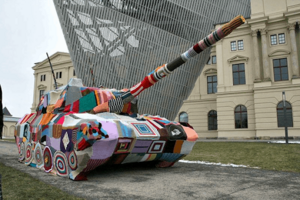
Even though there is the internet, handmade objects remain an important medium to spread the DIY culture. While the internet is a very innovative and quite effective medium, it lacks the tactility of a handmade, physical object for the bonding with it. It also lacks the learning experience of making something yourself instead of just looking at someone else making things. So if “laziness” is an outcome of available information about making processes, then that would be a pity. The internet is much more efficient for distributing a subject than via objects. If it isn’t necessary to use sources from nature to produce a product, it would be better for the environment not to produce objects then. Objects (like zines), on the other hand, feel more substantial; they seem to have more weight as a replacement of main stream culture, which makes them suitable for a variety of topics. The DIY movement has this ethos about anti-consumerism that clashes with the main stream culture: DIY’ers reject the idea that you can pay other people for a solution to all imaginable problems. DIY is more like an attitude than an activity.
In 2003 Betsy Greer even combined the words “craft” and “activism” in the word “craftivism”. Craftivism describes the political choice of resistance made by making things yourself instead of just buying them somewhere. Making things yourself is good for your self-esteem instead of disempowering and you can add a personal side to your objects. It is interesting to see how craftivism can spread a pro-active, positive message, where people usually try “stop that”. Since craft has such a personal influence and representative power, it has the capacity to bring across a rather striking message and it gives people the opportunity to join such a movement. With environmentalism and sustainability (which has to do with autonomy, mobility and social patterns) the fact that the practical part actually binds people with the protected materials enhances the other bright sides of craft. It can be easy not to feel responsible for Wicked Problems, but it becomes harder when you get to feel more connected with the environment.
The spirit of craft can also become visible in other ways than a direct physical manifestation. To help create sustainable social patterns, craft can be redefined as daily human behavior that we practice with each other on a daily base. So everybody is crafting already and we are the material, but we can become more aware of that fact and how we make a difference thus. We can start crafting gentleness with friendlier values than the harsh “right” or “wrong”, that put some people in a bright spot an others in the dark. Values like “helpfulness” and “appropriateness” might help. The power patterns can change. The society doesn’t have to look like a closed, unliving system in this way. Craft doesn’t have to mean hands on, but it occupies all interactions with nature (including people).
Critique on the word “craft”
When Ruskin and Morris were discussing “craft” in the 19th century, “craft” already had a conservative reputation. If craft is fundamentally the opposite of the processes of modernization, then handwork could only have a small impact on society within a capitalist economy. People still believed that craft could have multiple functions though: craft could function as a retreat (a withdrawal from modernity), craft could soften the hard edges of the modern daily life or craft could take a role like fine art. The following could be corrected or used as a footnote by Ruskin’s and Morris’ texts: apparently there were more artisans in 1850 than in 1750 actually; “labor aristocracy” happened already in the Medieval Ages, when highly trained craftspeople defended their privileged position in the Medieval Ages; the new mechanical tools from the Industrial Revolution enriched a lot of production processes that still entailed handicraft and the making of industrial tools and machines depended on craft.
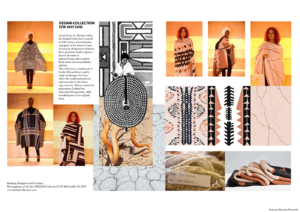
The term “craft” was invented halfway the 18th century already as an attempt to position the power of hand skill as a supplementary one, because from then on it seemed possible to categorize craft. Actually it was common knowledge back then that artisans could practice a powerful form of control. Halfway the 18th century a shift took place in artisanal workshops: the division and specialization of labor, so that the executer would start to be seen as “generic”. Craft gained the meaning of only a possible part of a production process. In other words: the division of labor started before the Industrial Revolution and actually had to do with the mystical power of hand skill.
Some tractable materials like cast iron, papier-mâché and rubbers were seen as so plastic, that people have believed for a period that designers could model them with their mind. Inexplicable things (like craft or magic) used to hold great cultural status. Now people are afraid of them and want something that they think they can control with words. Writing about craft was used by Victorians as an attempt to diminish the control that craft had. Fortunately for craft, it is very difficult to “explain” craft and undo its “manipulative structures”. The amount of publishing of craft in the 19th century far transcended the utility. Instead of artisan’s endeavor for “mystery”, somehow there became one for a “self-serving form of explicit description”.
Before the industrial revolution and outside of Europe and America, one could not even speak of craft as a separate field. Any serial production needed a lot of hands. Since the term is quite new and from Europe and America, the term might suggest that before the second half of the 18th century and outside of Europe and America there haven’t been stories of transformations within processes of production- it would all “just” be “craft”.
Craft was actually a prop to promote imperialism. Colonizers used what they considered craft as an antithesis of industry. A clear contrast started appearing between the influence spheres of imperialists with their industry and the areas where colonizers had no influence. Industry was seen as “inventive, progressive, technological and efficient”, while craft was considered to be “static, trapped within tradition, slow and intuitive”. Modern ways of manufacturing were considered to produce “superior quality”. To craft the reformers assigned some positive qualities too, like “creativity, rootedness and authenticity”. Talking about “others’ authenticity” suggests a description of “other” culture from a Eurocentric view. They idealized ways of living of people that they considered to be outside of their own culture, while “reforming” their religion, manufacturing, and everyday life. Many Europeans and Americans considered their vision of improvement as something that’s necessary to be civil. In this sense the invention of “craft” is in the end part of modernity ([8]).
The battle of art and craft
The concept of craft only took its defined shape, when other crafts decreased by the industrial revolution and mass production. The two concepts- industrialization and craft- are opponents that create and support each other’s meaning. The concept of “craft” and “art” define each other in the same way: “craft” makes it possible for “art” to take its position.
Craft can be looked at as an idea, category, more loosely than as just things that are handmade in a certain medium. Craft can be considered as a quality of which every artwork consists. Craft has created its own cultural and economic value though. It would not be fair to put craft under the term “art”.
There are three main so-called differences between art and craft: a modern artwork is usually considered autonomous, while craft is seen as supplemental. Art is more about optical effects, where craft is more about the material experience. Skill usually plays a bigger role in craft than in art, because skill shows that craft is rather an active, relational concept, where art seems to be more like a fixed category.
Craft has its own boundaries and is more defined for that reason. The separation with art makes it easier to look at craft itself. Art can be aggressively autonomous: “don’t touch me”, so it can be easier to relate to a well-crafted artefact. Whether something falls into the category of art is most of the time depending on external factors. The autonomy of art is therefore debatable ([9]).
Walter Gropius: Bauhaus Manifesto
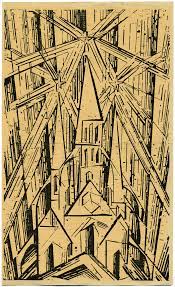
After WWI many people in Germany believed that the artist could contribute to creating a change in society by making new visual surroundings. The Bauhaus in Weimar became the center of this attempt, not just of Germany but of entire Europe. Walter Gropius (1883–1969) wrote the Bauhaus Manifesto in 1919. The central point of the Bauhaus Manifesto is to unify all creative effort by creating an organic learning environment that is open for anyone to join. When someone wants to learn to master a craft, one can get educated by craftsmen and maybe learn how to make art from that base. Art by itself has pretty much lost its unity, which makes sense, because art has transcended all methods. Craft however can be taught. In craft lies the prime source of creative imagination.
The Bauhaus Manifesto has a geometrical church as an illustration. This illustration is emphasizing the metaphor of the unification of creative processes as a building: all the parts should be appreciated by themselves, as well as in the shape of a whole. It looks like a church with shining stars, which might stand for the sublime power that might be achieved this way. The three stars represent three important arts: painting, architecture and sculpture. Just like a Medieval cathedral the Bauhaus as a building became a meeting place for all education in fine art.
In the first years of the Bauhaus Walter Gropius was influenced by the ideas of William Morris and the Arts and Crafts movement. Gropius writes about the importance of returning to the crafts and creating together, just like Ruskin, Morris and Marx. He also wishes that the value of craft would be recognized. Beautiful objects can only be achieved by crafts.
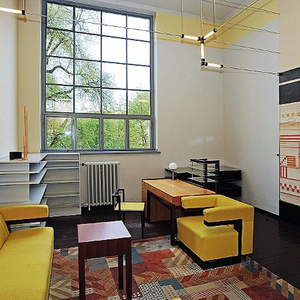
The term Gesamtkunstwerk is introduced. Gesamtkunstwerk is an architectonic concept. It means that an architect wants the entire building to be a whole. For that reason he designs and makes the interior as well as the building, e.g. wall paper, furniture, flours and decoration. Around 1922 however the ideas of the Bauhaus took a shift because of the influences from De Stijl. The Bauhaus moved towards a cubistic simplicity and functionalism, especially in the field of industrial design. The Bauhaus had to design for mass production, because otherwise the designing was financially impossible. In 1923 the new slogan was “art into industry”. The focus on craft remained though. The learning environment of the Bauhaus did away with the hierarchical, rigid structure that craft faces elsewhere. A part of the concept of “craft” has been to have power in one’s own hands define itself, but in the Bauhaus that wasn’t completely possible, when it turned out to be necessary to design for mass production ([12]).
In 1928 the new director of the school was Mies van der Rohe. Mies van der Rohe and Walter Gropius moved tot he USA and spreaded there ideals there. The school was closed in 1933 by the nazis. Architects of the Bauhaus found their refuge in Tel Aviv (Israel), where they built the White City ([13]).
The art and design education of today has been influenced by the Bauhaus. The Bauhaus has no real hierarchical structure of art and craft and there are no real authorities in the institutes. There are mentors and facilitators of students. Bauhaus was popular in the art and design education in America. The focus in The Bauhaus laid on the growth of the artist who designed products for the whole society that were industrially made. The Bauhaus brought design to the social status of fine art and embraced the new technologies that came with the machines for this purpose. This was a time with big other changes too: there were new social power structures in the working environment, new concepts of beauty (the most intimate personal views in expressionism and the abstraction in constructivism) and a shift away from social classes in society. The Bauhaus and Black Mountain College merged the ideals of the Beaux Arts with those of Arts and Crafts. Design and all arts were equally important to enrich and improve the society. From psychology and sociology came the concept of the importance of individuality and artist perfectly knew how to represent that. “Teachers do not work according to any predefined definition of art, not even their own, but rather challenge their students, discussing with them concepts which call into question artistic traditions as well as social norms and values. Institutes which now serve as models for others, do so based on their curriculum and the professional reputation of their teaching staff. An institute’s success is not based on its educational philosophy and underlying definition of art, but on the subject matter of the curriculum and the reputation of its teachers and alumni” (page 13; ([14]).
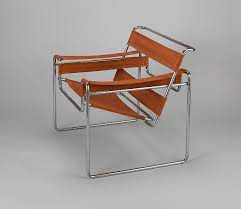
Two of the directors of the workshops of Bauhaus were especially popular: Marcel Breuer (1902-1981) and Gunta Stölzl (1897–1983). Marcel Breuer directed the cabinetmaking workshop from 1924 to 1928. The Bauhaus aspired to deliver prototypes for the mass production of everyday products. This pursuit was best accomplished by making furniture. Breuer made a chair that was one of the most important products of Bauhaus. His chair connected conceptually with Gerrit Rietveld. Breuer and his studio looked for the chore of furniture, which leaded to minimalistic chairs and dreams of the most lightweight chair. The chair that Marcel Breuer created in is still being made today and was inspired by his new bicycle. Gunta Stölzl directed the textile studio. She and the studio took the character of weaving from a supplementary one towards a broader art. They researched color theory and looked further into possible shapes with weaving. Stölzl and her studio maintained the Bauhaus a lot financially with their sales. Their textiles gave the interiors of the Bauhaus a colorful and abstract optical effect. In the studio there was a lot of experimentation with materials like cellophane, glass and metal. The studio was run by mainly women. Women were actually not really accepted in the other studios. Though weaving had been kind of an unnoticed art with bad working circumstances, Stölzl took it with the students in her studio to something with status. Anni Albers (1899-1994) was educated here and became an important textile artist. She was inventing and writing about contemporary fabrics for a big part of her life ([16]).
Added notes from the 21st century about craft
The development of software offers a new medium to create visual artifacts. Though this medium is not exactly tangible, the creations are still a result of the relation between hands and the mind. The personal making processes in digital media keep the human touch alive in architecture, painting and modeling for instance. Hand-eye coordination, the image culture, the tools and the interaction with an interface play a role in those processes and improvisation is often necessary ([17]).
There is also a manifesto about ownership of products that has to do with making and repairing. Product should be designed in such a way that the user can repair it, if it’s broken. It should be possible to replace parts and open it up without making it completely useless ([18]).
The making culture can be quite dominant nowadays and focused on a traditionally male role in society. The fact that one makes beautiful furniture for example doesn’t have to become the thing one is known for. It is also important to actively appreciate work that doesn’t produce objects for sale- like the work of teachers and caregivers ([19]).
Wrapping
During the practice Digital Craft all students were in a group that would explore a making technique. I was in the group “Wrapping”. In wrapping our goal was to produce samples of machine embroidery and knitting, to research small-scale textile production and tinker with electronic textile techniques. The definition that we used of wrapping during the course was: a technique to construct (textile) without irreversibly changing the used material. The biggest examples of wrapping are knitting, weaving, knotting, binding, sewing, tufting, twisting and twirling.
The history of wrapping
The biggest influencers of the modern textile production process have been: Siberia from ca. 6000 or 5000 B.C., the Chinese textile manipulation from around 3500 B.C., the Egyptians from the first century B.C. and the Europeans form the fifteenth century during the Renaissance onwards. Textile usually functionates as clothing, shelter, ornaments, art or decoration. Some textile techniques are also necessary for creating baskets, hunting, pulling something heavy, binding and climbing. Especially clothing is strongly related to culture.
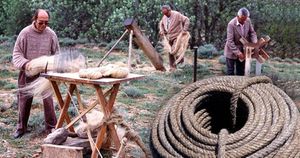
“Wrapping” usually starts with a thread and a needle. The most common thread is the thread that’s created by a technique called “spinning”. Spinning is a technique, where fibers from usually wool, flax or cotton are twisted to create a thread. An important tool for this process is the spinning wheel from 500 A.D. in Asia. Before the use of the yarn from spinning people used animal parts, like veins, sinew and catgut. The bones were used to create needles. In Africa people combined sewing with weaving leaves to create baskets. Organic ropes (like lianas) were popular. The ancient Egyptians made rope from papyrus from 4000 B.C.. There were also ropes from date palms, flax, grass, leather and animal hair. From around 2800 B.C. there was the Chinese invention of rope made of hemp. This invention caused a great spreading of the craft of rope making from Asia to Europe.
In England and via Europe and America, the Industrial Revolution (from 1750) brought upon people the invention of a working sewing machine and other textile machines, like those for embroidery, weaving, crochet and knitting. This gave the means for an economic development, because it was suddenly possible to produce a lot more quantity on a working day. For housewives the new sewing machines helped them to do their cores more quickly, so they could actually look for employment. In that way they could even provide more for their family. The fact that making clothes and shoes took less time from employees, made the clothes and shoes less expensive. In time the sewing machine also became cheaper. Low prices for ready-made clothing eventually concurred away making clothes at home, except for as a hobby or for if the clothing is very detailed.
The clothing industry affected the manifestation of culture and multiple industries: the expanded need for cotton demanded more cotton fields, more (metal for) needles and transfer. Plus there is replacement of employees by people in countries with lower costs- thus there has to be more international transfer, like shipping. This especially happened when synthetic fibers were getting more and more common in the 20th century. A lot of ruling technologies in the fashion industry are “Western”. (The patent on an invention can be bought or demanded, plus the technologies are at least executed mainly by people in Asia nowadays.) [21]
Studio practice
Historical example
My studio practice has started with the old making technique knitting. Knitting is the process of making a textile out of one thread with multiple needles. Knitting originated from single-needle knitting: creating loops with a needle and pulling a thread through each loop to create a new loop in order to create a fabric of loops. The oldest found single-needle knitted fabrics are from the 7th century B.C. from Israel. Knitting was usually necessary for making clothing. The oldest pieces of clothing from single-needle knitting that we know of are from Egypt: socks out of the 4th century A.D.. Between the 11th and 14th century there were socks that were knitted with multiple needles in Egypt. Later on in the the Middle Ages the technique of knitting spreaded towards Europe, probably via Spain that was dominated by the Moors.
When I think of wrapping I firstly think of wearing clothes and quite soon after that I think of the clothing industry. In the clothing industry the fabrics are usually either woven or clothes are fabricated by a knitting machine. I was surprised, when I learned that T-shirts are quite often knitted. I actually used to associate knitting with someone doing a relaxed, inward activity that would eventually produce something quite expressive.
As my first example, I’d like to show a scarf that I’ve knitted. For this long scarf, I’ve made use of the weft knit (Single Jersey/ plain knit). In the photo you see the reverse of the fabric, as I wrapped it around my neck. I’ve chosen wools with a variety of thickness and a lot of colors. When I stumbled upon these wools with multiple colors, knitting was new to me. I was very enthusiastic and curious to see the yarns unwrapped to look at the color transitions. I wanted to make something with it and knitting seemed a good start to make something with a lot of wool at home. It was nice to start knitting a scarf, because I could get adjusted to the movement with my hands and arms and enjoy the process of the scarf growing. I didn’t do purling yet, but I attached multiple wools to the scarf and finished it by creating fringes with a crocheting needle. My mother and grandmother actually taught me how to knit. For my grandmother it actually used to be a necessary activity to knit sweaters. Now they were helping me to learn to knit more like a hobby. My scarf became large and it turned out to become quite an expensive project. My friends liked the scarf and it was so tall that we could share the scarf. One friend said that I didn’t knit it as one is supposed to knit a scarf. I actually enjoyed the attention the scarf got, because I put a lot of attention it for some weeks. I vaguely associate the result with “yarn bombing” from the 00’s onwards, as shown in the picture with the tank. While making this, I really started to feel how much of a connection I can have with a “product”. Even though such a scarf might not “match” with quite a lot of clothing and I made the mistake of giving it no variation of stitches, I like its softness and its quirky colors still make me smile.
As I don’t have pictures of the knitting process and I feel like I should show some more for this practice of diving into the old making technique knitting, I’d like to tell about textile classes I followed after the practice.
After the practice I was following textile classes, when I was studying to become a Waldorf elementary teacher (but I followed only the first year in the end). In these textile classes we got assignments to learn the history of textile production as well as practical basics. We focused on knitting. With a spinning wheel I made my own thread after carding the wool. Later on I made my own needles from wooden sticks. I sharpened the ends of the sticks and glued a sphere on the other side. Then I tried to knit with my own thread with my own needles. Later on I’ve made a gnome with these needles. I decreased and increased stitches, changed wools and did knitting and purling. This is a gnome that children usually in the age of 6-7 make and that we made too to understand what they might experience better and what they might need from us (as a teacher). The gnome is usually the first piece of knitting that people within the community of Waldorf produce. Making a creature some (young) people belief in and which is famous from folklore tales by knitting is quite a balanced activity in the sense that one works with the hands, heart and the head. To create the shape of the gnome one has to count stitches and thus focus. The gnome is a often loved creature and can become exactly how you’d want it to be. You can get attached to it quite easily by the knitting process. Knitting is also a good motoric practice to stimulate the coordination that is needed for writing for example.
During these textile classes I came across this beautiful long leather coat with a fur collar in a thrift shop. When I tried it on, I immediately saw that the sleeves were way too short. I decided that I would knit the sleeves by myself and that I would look for the wool in my home town. To create the sleeves I was practicing in a new way with alternating knitting and purling. Again I felt extra attached to the coat and what I knitted than I usually feel attached to clothes.
I consider the outcome of the assignment of the historical example mainly as a warming up in the end. What it did bring me was a fascination for the movement of the thread during a making process and some fantasies of being a part of that thread. As I enjoyed this excitement I did want to find a way to bring that experience more clearly across in future outcomes. I also visited the fabric station to see the knitting machines and try them out. I found them quite complicated, but was hesitating for the next example whether I would choose knitting or weaving. In the section comparative example, I shall tell more.
Comparative example
Within this experimental example I compared different techniques of weaving and I tried different materials. Weaving is the technique of constructing a fabric by wrapping a horizontal thread across vertical threads that are usually fixed. Until the sides of the fabric are sewed a weaving can be unwrapped without the material being changed. I was interested in weaving because this technique is very important to create textiles that are necessary for the clothing industry. I hesitated between knitting with the knitting machine and weaving on a computer driven loom. Eventually I made my decision based on my wish to create a wrapped textile with a cuddly appearance by either knitting or weaving. The cuddly appearance seemed better manageable with weaving and creating loops than by working with the knitting machine. The weaving loom itself also spoke to me more at the time.
During this practice I was fascinated by vivid and lucid dreaming. When I had this type of dreams, I could feel trapped into them and during the day I would hesitate whether I was truly awake. This hesitation especially happened, when I woke up in a new dream after dreaming. It scared me that something might be wrong with me for a while and it came along with some nightmares at first, but I’ve read that only the fear of having a lucid dream and postponing my sleep is sort of destructive behavior. During the day I would do “reality checks”. It took some time to find something that distinguished my dreams from my waking state. It started by asking people whether this was a dream and that started some conversations about reality and (shared) consciousness. It was a bit difficult to trust that I was awake and I was also a bit careful in my dreams, because it might be reality and my actions might have actual consequences. At some point in my sleep I was flying away from a light nightmare on purpose and I felt extraordinarily happy.
The conversations about consciousness, reality and dreams led to questions about the nature of dreams, psychology, which part of reality we share and even about biology. Though these conversations with friends were kind of intimate, they also made me think that we could never know what somebody else experiences and I felt like too many things were all questionable all of a sudden. I started hesitating sometimes whether I was actually living my life, while I always stayed convinced that I was.
Out of these conversations came some hypotheses about the differences between the waking state and the dreaming state of mind. Along with those hypotheses there were also ideas about how to relief myself from multiple vivid nightmares in a row. In the waking state other people would have a consciousness too and that is something that I would have to take for granted. In my dreams, a friend told me during the day, friends could only behave as I expect, fear or hope them to do, while in the shared reality they are more unpredictable. Another friend said that I should look at my hands and that it would not be possible to see them in a dream. What worked quite easily actually was to check whether I got out of bed and whether I could remember getting in. The natural laws and time are also helpful. When there is a nightmare and I realize that I’m dreaming, I can tell myself that I am safe and in control. What would I want to happen?
We talked about nightmares too and about learning to accept your own fears. I could look my fear in the eyes, observe it, listen to it, but understand that the fear on its own doesn’t have the power or will to do me harm. It is something I am creating unconsciously. I can give it power unfortunately to grow and block myself. Being afraid of the fear and avoid fearful events makes the fear worse, while getting to know it and letting it be has helped me from time to time. To get familiar and maybe even comfortable with some of my fears I wanted to visualize them and make them very tactile- as if they might even have some kind of minor personality.
When I watched the French movie “Le Tout Nouveau Testament” (2015) about the daughter of god rebelling against him, I noticed that I felt very uncomfortable and by the idea of being observed as a few pixels and easily controlled by a god (from behind his computer). We could easily be overlooked and hurt as some pixels, which triggered some fear. I started trying out this assumption: When the screen is showing only a glitch or snow, then we might lead an unpredictable and unprotected life. Together we would create a moving image that seems almost white from a distance and isn’t telling any of our stories by itself. When there is a glitch in a movie or on a picture of a screen, a pixel is actually more outstanding. When I take a picture of the screen, the pixels also show differently in the image. It looks like a pattern of drops in a river. For now I'll call this pattern a glitch too.
The idea of being part of something that is displayed on a screen wrapped itself around the hesitation I sometimes felt about whether my friends were my actual friends or just part of my dream. What if all the creatures in my dream have a consciousness too and I am part of another consciousness? What if my life is just part of somebody’s dream and my thoughts aren’t mine?
In the fabric station was a computer-controlled, manually-operated weaving loom. I thought it was interesting that the weaving patterns on this weaving loom are now controlled by a modern computer, because the design of early computers is actually based on punch cards for weaving patterns of the Jacquard loom. From a huge mathematical tool a computer developed towards an immersive screen with a lot of- almost hidden- technology behind it.
The screen and a woven fabric both have a clear grid. It looks like the thread has been replaced with a flash of light on a computer screen. By weaving the glitch, I might freeze this moment where I consider the “pixels” to be finally “free from the grid”, but out of control. Can the “pixels” (people/threads) be autonomous, but work with the structure of the grid? Can the grid be a pleasant place? I can frame this fear into a rectangle and keep my mind focused on the movement of the slow weaving process. The grid might be a parallel with the natural laws or with different (sub)cultural perceptions. The (vertical) warp threads are the rules around which we move.
After I practiced weaving a pattern on a smaller weaving loom by hand in the fabric station, I alternated Tabby weaving with a drawn pattern that was controlled by the computer next to the weaving loom. For the pattern I drew something that made me think of a drop in the river that repeated itself. In the fabric station there was a very thin and soft thread from wool. With this thread I mimicked an empty white computer screen and eventually I came closer to mimicking the glitch. I used white, red, yellowish-greenish and greyish blue. I was pulling some threads loose of the weaving to make it more tactile and quirky. The weaving process was kind of hypnotizing. Because I was looking at the fabric a lot, I thought that I knew every detail and it looked like a landscape to me. Though I was weaving one long piece of fabric, I was thinking of making two pieces of textile from it.
The first piece of textile was the part with white wool. This fabric was the one I associated the most with a screen in the end. I projected a Charlie Chaplin movie on this “screen” with an old film projector, because I liked the idea of the film being a wrapped material by itself too. To me the screen has a bit more of a “personality” of its own now and it reminds me of glitchy images. I also liked to see the combination of an old movie and my new “screen”, because it gave me a new impression of the silent film. [insert image 1]
The second part of the fabric was part of another idea. The fabric could react to an audience. I liked it if the weft threads wouldn’t agree with being fixed in the warp threads. I liked to show that the threads of the fabric were affected by someone closely looking at them, as if they were allergic. If the fabric looked like a hairy handkerchief with yellowish and green, it might be possible with wind or movement and sound to make it look like someone is sneezing in the “handkerchief” as the screen is approached.
After finishing these fabrics and creating short videos with it, my interest in the invention of film grew. The invention of film rose from a technique that involved wrapping images rapidly and film developed towards the digital medium. The manipulation of light has become quite untraceable for the public eye. A camera has captured some light and sound, but not the material itself. When someone watches the movie, they can experience a story very intensely though. The immersive character of film makes the film making process a good metaphor for the arise of a dream. In a dream all kinds of thoughts are wrapped or fused.
So for the comparative example I look back on three works, that started with the weaving process, dreams and the movie "Le Tout Nouveau Testament". I found that weaving was a way to clear my thoughts and yet it has a daunting effect on me. It seems like weaving can easily be a never ending process, even though I didn't set up the warp threads yet for this example. From these try outs I take with me the interest in the invention of film and the wrapping of images and thoughts that came along with it. It's a bit further away from weaving, but I still have room to experiment with materials that come close to film in this practice- to first make it a bit more literal.
Example of a new skill try out - learning curve
https://vimeo.com/329546992 password: practice22017
The next assignment was to show an example of a new skill-try out and to position ourselves on a learning curve. I chose to go with Jasmijn tot the ceramic station and try out throwing clay. We discussed whether this would fall into the category of wrapping and tried to define wrapping from different angles. For this experiment we tried to define it in a more abstract sense and took steps away from textile. Wrapping is a making technique to construct something out of one material without permanently changing the material. We argued that only the process of clay turning is wrapping, because the material clay is perfectly usable for another process after clay turning if left wet. We made the plan to focus on wrapping ourselves around the clay and vice versa.
After reading “The invention of craft” I was intrigued by the Victorian’s belief that crafting plastic materials is like a magical skill and that designers are modelling with their mind. It seemed interesting to work with clay in the ceramic station, because the material is so plastic and smells so natural that part of the process seems to have its own life. It’s growing and changing by itself, yet it let’s itself be manipulated. To me clay feels like a “gentle” material, because it seems “sensitive”. When I think of designers who are modelling with their mind, I think of how they can just make the clay grow in all kind of creatures and animate them maybe even. If it can look like one creates creatures or uses mind magic when working with clay, then the ceramic station could be a very good place to try to convey a sense of a dream.
We began with clay turning by grabbing a piece of clay and kneading it thoroughly. This part of the process took some muscle strength. Then we went to the wheel, placed our clay on top of it and took a seat. The table with the clay was attached to a lower weel by an axe. As we started kicking the lower wheel, we started the movement of the table. Just like with spinning a thread on a spinning wheel, this process takes some eye-hand coordination. We focused on getting the clay to go upwards and making the walls kind of even.
We got the advice to make our hands and fingers touch eachother and make fingertips work together with joints. The clay is being pushed by one hand and is resting on the other. Though our movements seem kind of repetitive and maybe even mechanic, the clay is going in all kinds of directions. The clay shifts shapes rapidly, even from the objective perspective of the camera. This shape shifting is what I like, but I don’t feel control over it yet. I should practice a lot more to achieve that. Our legs and hands can’t always move at the same time (sometimes there is enough speed and it’s easier to focus on the movement of our hands without executing another movement). As my perspective on the clay changes constantly and the shape isn’t the same for much time, I am focusing on the patterns or lines that stay for multiple seconds. Since I smell, feel and see the clay, while I’m also listening to and moving on Spanish songs, it feels like a very immersive experience. The experience makes me focus on my senses and feels meditative.
Looking back, I think that points of improvement would be to look if the walls have the same thickness everywhere and to push the sides inwards. When we were throwing clay, I wasn’t working with a strict idea of a result. It felt like the process connected a lot of different things into one experience and it gave food for some reflection. Afterwards it seemed more clear what felt like wrapping about it to me and how wrapping could make me feel. These thoughts stuck with me to indicate how I felt about it: 1. it feels like I am giving and recieving a little massage; 2. The taller the object gets, the more mysterious it gets to place one hand in it. It reminds me of the covered holes in visitor centers of national parcs, where you can put your hand in to feel an animal without looking at it. I used to find it a bit difficult to trust those things.
After looking at ourselves in the movie, we thought that our movement looked a bit like a peformance and that the clay was indeed wrapped too. The “performance” made the idea of wrapping more present in the video than the clay perhaps. It was also interesting to have some symmetry in the video, because that actually made it clearer how different every clay turning process can be. It was quite satisfying to “recycle the clay” and only look back on the process in stead of a physical outcome. Our heads aren’t in the video, which I find fitting. Our heads might take away some attention from the rest of the movement. We were chatting during the process and I really liked that that was possible too. After this experiment I quickly focused on results again: I wanted to find and show more ways in which humans are being wrapped. I also thought that the movie has wrapped the process (of wrapping) and has some tacitlity because of the activity.
Horizontal axe: time (minutes)
Vertical axe: amount of time that I feel that I could continue doing this (minutes)
- (0,70) yes, let's do this. Very excited!
- (5,50) It looked so much easier... Am I this stupid/clumsy?
- (8,30) Oh, it's getting a little bit of a shape
- (10,20) Now it still looks the same
- (22,18) What shall I eat or do? When will I stop?
- (25,25) Maybe I understand a bit of a rythm
- (30,32) The clay feels alive and it's actually easy and soft to shape
- (32,38) This is a good therapy + work out session
- (34,40) Very nice music
- (36,42) It's more outstanding, when clay turning
- (38,43) No more stress
- (48,49) Yes, this is it... I am only going to do this from now on.
- (60,40) Even when I am old, this will be my everyday work out and I'll have one at home...
- (80,10) tired - putting the clay back in the plastic bag; squeeze... Gone shapes. Going home (after cleaning up)
Example of a material pushed to the limit
For the example of a material pushed to the limit I used an old casette as material. The interest in experimenting with materials that come close to film, got me looking at home for materials. The closest thing in my opinion that I could find was an old casette. I have woven the casette around itself with the help of some tape. I repeated starting with weaving a rectangle that might become a “screen” too.
When I was little, I often used a casette recorder to record things I wrote, melodies or songs. I always forgot them and usually didn’t listen to them neither. (I might have recorded over a casette by accident and fused the two.) Despite that there are still casettes in the house and the recorder is probably gone. Anyway, I still felt attached to the cassettes in a way and love to make them "useful" in a process.
When I read about the weaving workshop in The Bauhaus I liked to read that I worked with cellophane. I could imagine the beauty of the translucent character of the cellophane. I hoped that the casette would show that too and thought that I was pushing casette to the limit, because it is very fragile and gets messed up easily. Weaving it was a slow and careful process for that reason.
I ended up breaking the casette into pieces by weaving it and don’t know what might have been recorded on it. However I liked the wavy, abstract reflections that the weaving created and it gave a bit of an indication of what it felt like to weave with something that is as smooth as film. The casette weaving was a bit translucent indeed. Since I enjoyed the features of the material, I wanted to work more with images on translucent materials in combination with wrapping. For now I realised that the time was a bit up and that the material casette was not that much more inspirational to me as weaving material than I just described.
For this exampled I produced and designed a work together with the other student in the group of wrapping: Robin (Fashion), Dieke (Animation), Andres (Fashion) and Jasmijn (Fine Arts). We were discussing the meaning of wrapping again. We looked at what was wrapped in our surroundings. I think I was very enthusiastic -maybe a bit much- about abstract definitions of wrapping and getting started with a material.
We talked about nature and natural wraps, like peels and skins. We also saw animation as a wrapping process and talked about combining stills from an animation with textile techniques. From that we came back upon haute couture and performativity. Then we talked further about sustainability and the environment. We were looking for what kind of wrapping would also feel personal for all of us. We thought that mimicking an animal skin would show and trigger respect for the animal and we looked at a fashion book from Andres called “Skin”. We thought of using plastic waste to make such a skin. The plastic waste is plastic from the result of wrapping almost every product.
Then Jasmijn brought up views on the environment from an exhibition. The bottom line was that something with performativity or “human” material would be interesting to use, because of the empathy and questions it envokes and because of the message of depleted resources that it conveys.
On an excursion from Fine Arts Jasmijn and I had seen Slave City from Joep van Lieshout at Museum De Pont in Tilburg. In that exposition Joep van Lieshout actually made a speculative design of a sustainable, efficient city that could host the predicted population. Though that might sound nice, it is actually more kind of a dystopia. It is shown as the only was that people will be able to live, if they continue interacting with the environment in the way that they are. It involves normalized cannibalism, slaves and people’s organs need to be used as fuel. Joep van Lieshout also made a booklet for Villa Zebra for kids with questions and exercises to make them think about cannibalism. Empathizing in a person who is used as a material and harmed, but also thinking about using others as a material (in a peaceful was) was interesting.
Why are we not wearing human skins? Jasmijn was working with latex already and gave us instructions. We went to the ateliers to create fake human skin from latex. You can give latex a bit of color, it’s very flexible and yet a bit rough and it has this fragile look. It is also necessary with latex to work in layers and this gave us the opportunity to decide when the work looks the most like skin to us and how deep we would put the “blood vessels”.
While making the skin, we would look further what we would make maybe from the skin. We were thinking about a piece of clothing, so that it was destined for humans again. In the atelier we used a big piece of card board as a mattress. One person at the time for a specific body part would lie down or sit on it. Then we created molds out of pieces of plaster from an arm, a back, feet and a breast. The tasks were divided: someone cut the strips of plaster, someone put the strips on the person, someone was getting water, someone prepared the latex, someone painted latex in the dried molds and someone else helped to create details in the painted latex (like red threads of wool for vessels and a news paper as a tattoo). Later on we were moulding the skins into a coat or sleeve at Robin’s place. She had a mannequin. We were using tule, different embroidery techniques and improvisations and it felt like everybody was putting an own stamp on the coat. I loved that about this process. It also felt like everybody found some new inspiration from doing this project together.
Working with latex was interesting and I did try multiple tasks and to work on the concept. I did not “add a body part” of my own. I have felt a bit guilty for not adding one, but the feelings also interested me. I was actually a bit too concerned with own insecurities that would be far overshadowed if the heaviness of the topic would hit me harder. I was very interested in the latex itself and had to focus on working gentle with it. I barely took initiative and maybe even avoided being a model too for a body part. I felt ashamed by the idea of taking off clothes around them and them smearing my skin with vaseline. I also feared that I would sweat a lot because of the nerves and that I might have a rash or pimples that they would find gross. I was also worried that they would not dare to break the agreement of making a mold out of a body part of mine, when they might want to. I wondered, but did not ask or notice, if they had those kind of feelings too in the process.
The scope of Slave City did not inspire me deeply after the shared example. Maybe it did have much impact and it subconsciously created some sort of utopias in my mind and forms of denial of dystopias. I was still believing that I could always decide to withdraw from society, whenever that’s inevitable. In that sense I guess that I don’t believe that in a few years it could affect me. The coat of latex skin inspired me and I think it does look a bit lugubrious. We talked about so much and it helped me open up a bit more, I think. For the presentation and further projects I’ll continue looking at wrapping with something human involved.
Presentation & Surprise assignment
The things that I brought for the presentation were a collection of things that surprised me most as part of the practice. I think I didn’t bring the weaving from the fabric station to the presentation. In continuation, I’d like to show a few steps that I took after the presentation.
While working on the presentation, I actually think to myself: I am not really a wrapper. Maybe it’s stress, but it sounds true. It feels like the only thing that’s truly wrapped under my influence are my thoughts. I don’t make works in such a way that I’d ever test whether I can unwrap them and see that the materials have remained unchanged. I make knots and cut threads or I work without a physical result.
I can only follow my thoughts and wrap them without losing ideas from time to time. I can think of wrapping and then consider “being wrapped” and other creatures “being wrapped” or “wrapping”. It seems like an agressive act almost. Maybe I adressed these concerns of being wrapped already, when I was talking about being only a pixel in a movie. Wrapping as a technique to create metaphors is something I enjoy.
When I think of being wrapped, I think of being wrapped in thought patterns and fears. This is something I can sometimes release myself from luckily. I think of seduction and manipulation. I also think of the panopticum (where one is in prison and is constantly under the surveillance of the watching tower, because of the round shape of the prison), constrictor snakes, light houses, performativity, masks and sea creatures with suction cups, hyperobjects (like black holes or climate change; something affecting everybody, but untangeable and impossible to really observe). I think of power relations and from there on I thik of social structures. I think that the word craft itself is stuck or wrapped in a definition, as I wrote about in the “critique on the word craft”. Craft in craftivism then again seems to rebell against values that are undermined or structurally wrapped in such a way that they aren’t present enough in a political system.
In my attempt at some craftivism, I’d like to quickly discover a new material for DIY clothing and/or building. I quickly found out that this was too ambitious for me. Anyway, I was inspired by fruitarians and not killing. Then I read about Jainism and continued fantasizing. I wanted to find a way of living in which nothing is killed (or hurt) and learn to actually wrap those materials. My ideal of that time would be that I could use a peel of some kind of fruit as a material.
The peel that I experimented with was a watermelon peel. The watermelon peel kind of had the same qualities as a pumpkin peel: it is very sufficient for carving. So I started carving the watermelons and of course eating the inside. Then I left the peels to dry and put them in vinegar for a while. Later on I could put boiling water on the peels and reshape them again. They would become soft and flexible, as if they had never been dry almost. There is nothing inside the peel anymore to give it stability, but only water in the peel itself that is evaporating. What shape will it take by itself? I thought of making a dress of them by sculpting them with aluminum sculpting mesh. I thought of sewing the parts together with a thread from peanut sheels, but couldn’t manage to make that thread. Then I thought of glue from honey, water and flour or of using human liquids as glue. The honey glue pretty much works. Reshaping the watermelon peels I consider a wrapping technique, but I don’t think it could be an applied design technique as I wished. It may pass as a box, because it is possible to collect pencils or memos in the sheels.
I was actually trying to make a natural box out of the watermelon too and found something that I could rant against a bit: a water melon in a square shape. A water melon peel in a square shape is from human’s perspective easy to stack. Easy to fit in a van. Then again they won’t reproduce and are less juicy than the curvy ones. Those observations may lead to the belief that the square shape is disadventageous to the fruit, thus for the plant itself too (probably). This mask is forced upon the melons by humans. What if those squares, those boxes, could grow their own way. In stead of making living, natural things fit into “easier” shapes, perhaps it’s possible to consider shells and homes of other animals as “boxes”. The natural box can be many things: a cover, a category, a structure or a shelter. Clothing is like a human shaped box in that sense. The process with the mesh wasn’t going any direction I liked, so I'll show later on what I did with some watermelon peels.
Next to the watermelon peels, I brought the casette weaving, the shared example was there and I showed a sculpture. The sculpture was based on a drawing about a woman merged with an octopus. It is a sketch for a collaboration with Karin Arink for a sculpture. It’s called the Pink Clown Trophy and it’s for Scott and Miss Muriël. Miss Muriël is a funny illusionist. She disappears in the smallest boxes, makes things disappear by accident and reaches out to the audience to make them part of her act. Like an octopus, she can seem awkard, but charming, from her appearance, while at the same time she has many strategies to trick her “prey”. It is a sculpture from aluminium sculpting mash and paper maché. The paper maché was in this case also a process of wrapping paper strips around the mesh skeleton with a first paper maché layer.
First I made the feet from clay and I carved a sculpture in oasis. Karin gave me advice during that process. After the pink clown trophy I continued the oasis sculpture and called it “Octadans. She is based on the previous sketch, but turned out to be quite different. She is not dancing as festive now, but more like an empty shell under the sea or a zombie. What will be her tricks? Who will be her prey? Will it still be fun..? I made the oasis wet to see if I could reshape it completely. Unfortunately, it is not wrapping material. I made a hollow sculpture, as if all she ever does is wrapping or performing in stead of showing authenticity. She looks quite similar from different perspectives. She looked quite manipulative to me and I tried to make her look fluffy as an attempt to make her look cute. I used red paint, glue and coffee residu. The powder sticked and the color fitted the sculpture quite well by making it more feminine. It became brittle and less detailed though. Maybe it has started to look like a melted ice cream rather.
After the presentation we got the "surprise assignment". We were supposed to combine two works of other students with one of our own. I chose to combine the casette weaving with the poster "I make to see the world" and the printing roll that showed a group of people. The image of the group that can be printed very quickly with a role said something about society or a group dynamic to me, the casette makes me think of different stories getting intertwined and the sentence about seeing is about being able to take the time to look at (glimpses of) processes.
Why I make
I make to be surprised
Crux
During the practice I noticed that I enjoyed reading and thinking about the expression of crafted things and especially within clothes. From engaging more with what I wear and how it’s made, it started to make sense to think about other ways in which I wrap (or cover) myself. However it was also very interesting to keep looking around me and try to reflect upon experiments with wrapping (like the film, melon peels and sea creatures). Though I could have looked more at my own behavior and my habits as performativity, I found that "learning a new skill", the actors in the silent film and "the allergic handkerchief" showed enough “performativity” and I focused on thoughts and feelings. Especially dreams fascinated me a lot and their sources from "real life".
After the practice I realised that I touched upon some different themes: water creatures, the invention of film/photography, textile techniques, wrapping techniques and thoughts. The research felt a bit out of control eventually with all the themes I tried to combine and the narratives that I might have held on to for too long. As I mentioned before, my presentation was basically a collection of things that surprised me most as part of the practice. The “wandering” is something I enjoy, but I like the fact that the making techiques that are for sure a wrapping technique are always able to shift my focus. Weaving makes me calm. It helps me process my thoughts and it changes my memories a bit into more positive ones. The fact that making processes seem to have a grounding effect on me and change my mind is refreshing and in a way surprising to me. In a way I feel more connected with nature and natural material, when I make. Within the shared exampled, I noticed that the making processes that we shared, changed the group dynamic. There seemed to be room for everyone at some point and perspectives changed. We all seemed a bit suprised at at least some point.
From the wrapping processes I noticed that the interactions were interesting- whether they'd be with the material or with others didn't matter the most. In his book Ervin Goffman used an inspiring quote[22]:
“Living things in contact with the air must acquire a cuticle, and it is not urged against cuticles that they are not hearts; yet some philosophers seem to be angry with images for not being things, and with words for not being feelings. Words and images are like shells, no less integral parts of nature than are the substances they cover, but better addressed to the eye and more open to observation. I would not say that substance exists for the sake of appearance, or faces for the sake of masks, or the passions for the sake of poetry and virtue. Nothing arises in nature for the sake of anything else; all these phases and products are involved equally in the round of existence.” - George Santayana
I related it to the topic wrapping because of my interpretation of the quote and the information about performativity and (the reality or construct of) social interactions from the book. Society seems to be a human construct, perhaps a form of wrapping, too. This is my interpretation of the quote and I think craft(ivism) might be able to contribute to more positives social interactions in general:
A mask itself is a natural thing, as long as one knows how to separate the concept of the mask from that of its inside. One can live wrapped inside a cover, as long as the person doesn’t try to identify too much or completely by that cover. This cover can be ones own performativity, that is perhaps used as a comfort zone.
To belong to a group, there are (unwritten) rules, like dress code and certain behavior. Some fit better into a group than others. To get to know the person outside of these (chosen) roles, the person has to be distracted, confused, feel surprise or any kind of unexpected emotion. Then the inner, untrained, more heartly self comes to the surface and shows. Because of the surprise there is no way for the person to hide or censure the (emotional) and honest reaction. One’s actions don’t need to be seen as so defining for a person. So what if someone has a habit and falls partly into a “category”. If they like the rules of a category, but not the specific habit, then they could easily just give that up and keep the social benefits… Other way around: if someone only likes a habit, why try to bond with the category..? An action in itself doesn’t make you, but can help you to see other roles that people make up and link to the particular action. Social behavior is just everywhere, which doesn’t mean it is fun/friendly… When there is a sudden difference in situation, it is possible to see how different someone can be from the social role. That is not to say that social roles are wrong, but that they are just that and don’t identify the individuals of a group usually, so they should not function in that way. They should not pretend to be any reason for racism and discrimination, since they can change without people actually losing their core- they seem more meant for people to find belonging, so they should reshape and keep the function they aim for: as a home, a shelter. To keep one warm and protected, while able to interact with what becomes “outside”. Humor can be a reaction to weird outcomes of human constructions and playfulness or experimentation can be a key for that. Also people should take these “rules” any way they like and kick them when they need that.
To wrap it up: I make to see new perspective(s), discover, unwrap my thoughts. I also make to become calm and feel different moods in the process. I want to feel the excitement of learning a new skill. I want to zoom in and out and get past frustrations, see mistakes as miraculous surprises from time to time. Creating something with my hands helps me to get comfortable with the unpredictable parts that I would probably walk away from if I could. I do not always make and can be afraid of repetitive work, get tired before I start. I can’t easily stop. I actually love being caught up in making and thinking about the making. Every thought should just start to fit in a metaphor with a making process, so that I can process my thoughts better, create new behavior.
Continuation (epilogue)
A dream originates from processing sensory stimuli during the day. During the day it is slightly possible to control thoughts. When asleep, the thoughts are wrapping or fusing. I want to create an image of this thought wrapping. To create this image I make a video of the weaving process from during the practice and print all the stills on transparent paper. The video of the weaving process consists of a lot of repetitive movements with slight differences. The material is very visible and even in the stills the fabric look tactile to me. With the printed stills I start a new weaving process. The tactility of the fabric in the images gets pretty much lost, but the new fabric is tactile in a new way. This idea from during the practice is something I continued after the practice and it seemed like it could be an infinite loop.
With the watermelon peels that I saved, I made a little 3D mosaic. It was inspired on landscapes that I saw from an air plane, a mosaic workshop and seeing ruins of old tombes. When I saw an old tombe, I read that people used to be burried in the open air. In time those tombes and other buildings are covered with earth. On the way home, the landscapes in the view from the air plane looked so magistic. I felt a realisation that many people are covered with earth there, but yet it felt peaceful. I made two people from clay and put the dried melon peels on top of it with the honey glue.
After the practice I realised that I touched upon some different themes: water creatures, the invention of film/photography, textile techniques, wrapping techniques and thoughts. I was inspired by a sea star that clingsed himself to mussel for example- natural wrapping. The same sea star attached itself to a lot of different things and is very flexible. Sometimes a sea star is close tot he land or even on the land close to the water. The sea star lays there in a way that seems so receptive and fragile. It let’s itself be overwhelmed by the waves and moves at its own pace. Because of its slow movement, the sea star isn’t much noticable sometimes. The sea star would explain meditation very well probably. It would seem so scary to me to let myself be overwhelmed like that.
The sea star inspired me to create a way to experience to be close to the water line for a longer time in a camouflaged way and without looking at what is coming exactly. Close to the WdKA I found a nice water line at Bolwerk: Nieuwe Maas. There was a dyke with algae (and moss?) growing on it.
At the time I had experimented a bit with making a tent by wrapping sticks with rubber bands. From a class I took the experience that I liked this process and that it’s possible to create triangles like that. With the triangles one create many shapes. I covered the triangels with paper. At first I thought of giving the tent a moss look. Now I thought it could also mimic algae perhaps. I wanted to give the tent a bit shiny and soft look with “hairs”. It would be nice if the tent looked like a creature itself. To make this happen, I have tufted some triangles by hand with threee colors of wool. The other triangels I covered with moss and greenish velvet (fabric). I liked that the shape of the tent matched a bit with the shapes of the stones from the dyke.
Since it was a “creature” and I was interested in the invention of film/photography, I thought of giving the “tent” the opportunity to “see”. I tried to make the tent a camera obscura as well. So I sewed an inner tent from a blackout fabric. Inspired by the pinhole cameras, I made a small holes in the inner tent and gave them covers attached by velcro. The entrance was also attached with velcro. The inner tent has ribbons (like tentacles perhaps) and is hanging on the flysheet. I took “pictures” with the tent (the black one). Building the tent outside and being there felt like a performance to me, even though I was on my own. I thought I might ask for attention and didn’t know if I was okay with that. I also made pictures that day with a DIY pinhole camera made from cardboard and covered with felt. I made a sort of collage from the pictures from the pinhole camera “box”. Via the collage this little photography experiment with the pinhole cameras as well as with my digital camera and my impressions of the day are wrapped together. I gave the "tent" a name: Pinhole Diermensie. (Pinhole was from pinhole camera and the experience of seeing so little. Diermensie was a Dutch mix of the words "dier" (animal) and "mens"(ie) (human/little human) and the word "dimension"/"dimensie". It felt like another dimension to be in the tent with a different passing of time. It felt as if I could come closer to my feelings and I thought this could be an animal experience.
- ↑ Gauntlett, David. "Meaning of Making I: Philosophies of Craft." Gauntlett, David. Making is connecting. The Social Meaning of creativity, from DIY and knitting to YouTube and Web 2.0. Cambridge: Polity Press, 2011. Book
- ↑ Burgundy, Drapers' guild of. (dedicated to St. Blaise). Notre Dame. A Window on Wool History. Semur-en-Auxois, 1460-1470. Stained glass window. Image.
- ↑ Morris, William. "The Revival of Handicraft." The Fortnightly Review November 1888. Magazine.
- ↑ Morris, William. Strawberry Thief. Victoria and Albert Museum. Strawberry Thief. London, 1883. Furniture Fabric.
- ↑ Gauntlett, David. "The Meaning of Making II: Craft today." Gauntlett, David. Making is Connecting: The social meaning of creativity, from DIY and knitting to YouTube and Web 2.0. Cambridge: Polity Press, 2011. Book.
- ↑ eV, Louise Combined seam. Yarnbombing Leopard 1. The Military Museum. Tank. Dresden, 2012/2013. Wool, knitted.
- ↑ Loboya, Ivili. Development of Dedani Collection F/W2017 cachemire blankets and poncho. Ivili Loboya, South Africa. Cachemire, knitted textile.
- ↑ Adamson, Glenn. The Invention of Craft. London: Bloomsbury Publishing plc, 2018. Book.
- ↑ Adamson, Glenn. Thinking Through Craft. London/New York: Berg Publishers, 2007.
- ↑ Gropius, Walter. "Walter Gropius, “Bauhaus Manifesto and Program” (1919)." 1919. Manifesto.
- ↑ Gropius, Walter. Gropius' office. Bauhaus, Weimar`. Interior.
- ↑ Gropius, Walter. "Walter Gropius, “Bauhaus Manifesto and Program” (1919)." 1919. Manifesto.
- ↑ Honour, Hugh and John Fleming. Algemene kunstgeschiedenis. Zestiende druk. Amsterdam: Meulenhoff, 2013. Boek.
- ↑ Chabot, Jeroen, et al. "Reinventing the Art School, 21st Century." September 2013. WDKA. PDF. 21 February 2023. <https://www.wdka.nl/storage/2017/05/WdKA_Re-inventing-the-art-school.pdf>.
- ↑ Breuer, Marcel. Wassily Armchair. The Metropolitan Museum of Art, Bauhaus, Weimar. Armchair.
- ↑ Griffith Winton, Alexandra. Essays: The Bauhaus, 1919–1933. Ed. Heilbrunn timeline of art history. August 2007. Website. 21 February 2023. <https://www.metmuseum.org/toah/hd/bauh/hd_bauh.htm>.
- ↑ McCullough, Malcolm. Abstracting Craft: The Practiced Digital Hand. Cambridge, MA, USA: MIT Press, 1998. Book.
- ↑ Torrone, Phillip. "Owner’s Manifesto: Maker’s Bill of Rights." 26 November 2006. Makezine. Website. 21 February 2023. <https://makezine.com/article/maker-news/owners-manifesto/>.
- ↑ Chachra, Debbie. Technology: Why I Am Not a Maker. 23 January 2015. Website. 21 February 2023. <https://www.theatlantic.com/technology/archive/2015/01/why-i-am-not-a-maker/384767/>.
- ↑ CUERDAS Y SOGAS artesanales. Elaboración y trenzado con fibras vegetales en 1996 | Documental. Dir. Eugenio Monesma - Documentales. 1996. YouTube video.
- ↑ Postrel, Virginia. The Fabric of Civilization: How Textiles Made the World. New York: Basic Books, 2021. Book.
- ↑ Goffman, Ervin. The presentation of self in everyday life. New York: Anchor Books, 1959. Book.
